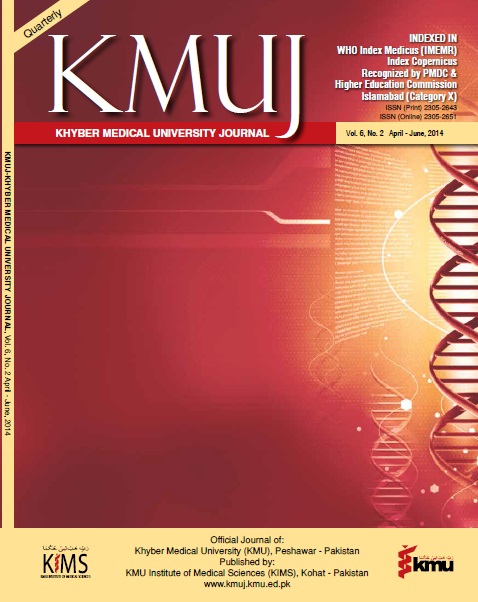EFFECTIVENESS OF TRIBULUS TERRESTRIS FOR PSYCHOPHARMACOLOGICAL ACTIVITY ON LIGHT/ DARK BOX IN NMRI MICE
Main Article Content
Abstract
Objective: to evaluate the anxiolytic effect of Methanolic extract of Tribulus terrestris (MeTt) in Abino mice.
Methods: Tribulus terrestris leaves were collected at the Botanical Garden of the Hamdard University and were identified and authenticated from Eastern Medicine Department of Hamdard University Karachi. Abino mice (30-35 g) of either sex were obtained from the Animal House of Dr.HMI Institute of Pharmacology and Herbal Sciences, Hamdard University, Karachi. Anxiolytic activity was determined using light/dark (LD) test which is commonly used in rodent for anti-anxiety-like behavior that is based on an approach/avoidance conflict between the drive to explore novel areas and an aversion to brightly lit, open spaces: Total thirty six (N=36) mice were randomly divided into six groups. For each of the model studied (n=6). The groups include controls (vehicle) and standard drugs (Diazepam, Bupirone, 1mg/kg) and three groups of MeTt (50,100 and 200 mg/kg.).
Results: MeTtat doses of 50-200 mg/kg significantly (p<0.05, 0.01) increased the latency of entry into the dark box with peak effect produced at the dose of 50 mg/kg (178±28.8) seconds) compared to control (132±9.1 seconds). The extract at doses of 50-200 mg/kg significantly (p<0.05, 0.01) increased the time spent in the light box with peak effect at the dose of 50 mg/kg (178±28.8 seconds) compared to control (132±9.1 seconds). The effect at this dose was not significantly different from that of diazepam (144.5±34.9seconds).
Article Details
Work published in KMUJ is licensed under a
Creative Commons Attribution 4.0 License
Authors are permitted and encouraged to post their work online (e.g., in institutional repositories or on their website) prior to and during the submission process, as it can lead to productive exchanges, as well as earlier and greater citation of published work.
(e.g., in institutional repositories or on their website) prior to and during the submission process, as it can lead to productive exchanges, as well as earlier and greater citation of published work.
References
Evstatieva L, Tchorbanov B. Complex investigations of Tribulus terrestris L. for sustainable use by pharmaceutical industry. Biotechnol Biotechnol Equip 2011; 25: 2341-7.
Tutin T. Flora Europaea. In: Tutin VNHTG, Burges DM, Morle DM, Valentine, Walters SM, Webb DA, Eds. Flora Europaea. vol. 2 Cambridge: Cambridge University Press 1968.
Zhange S, Li H Yang SJ. ActaPharmacol sin. 2010;31(6):671-8A
Bourke CA. Abnormal turning behaviour, GABAergic inhibition and the degeneration of astrocytes in ovine Tribulus terrestris motor neuron disease. Aust Vet J 2006;84(1-2):53-8.
Bourke CA. A novel nigrostriatal dopaminergic disorder in sheep affected by Tribulus terrestris staggers. Res Vet Sci 1987;43(3):347-50.
Antonio J, Uelmen J, Rodriguez R, Earnest C. The effects of Tribulusterrestrison body composition and exercise performance in resistance-trained males. Int J Sport Nutrition Exercise Metabol 2000; 10: 208-15.
Kessler RC, Chiu WT, Demler O. Prevalence, severity, and co-morbidity of 12-month DSM-IV disorders in the National Co-morbidity Survey Replication. Arch Gen Psychiatry. 2005; 62:617–27.
Kasper S. Social Phobia: The nature of the disorder. J Affect Disord. 1998; 50:S3–9.
Baldessarini R. Drugs and the treatment of psychiatric disorders. In: Hardman JG, Limbird LE, editors. Goodman and Gilman’s The Pharmacological Basis of Therapeutics. 10th ed. New York: McGraw-Hill; 2001. pp. 399–427.
Suresh K, Anupam S. Apigenin: The anxiolytic constituent of Turneraaphrodisiaca. Pharm Biol 2006; 44:84–90.
Eliana R, Ricardo T, Jose C, Galduroz F, Giuseppina N.Studies in Natural Products Chemistry. Vol. 35. Brazil: Elsevier; 2008. Plants with possible anxiolytic and/or hypnotic effects indicated by three Brazilian cultures - Indians, Afro-Brazilians, and river-dwellers; pp. 549–95.
Adnaik RS, Pai PT, Sapakal VD, Naikwade NS, Magdum CS. Anxiolytic activity of VitexNegundo Linn. In experimental models of anxiety in mice. Int J Green Pharm. 2009; 3:243–7.
Jain NN, Ohal CC, Shroff RH, Somani RS, Kasture VS, Kasture SB.Clitoriaternatea and the CNS. Pharmacol Biochem Behav 2003; 75:529–36.
Crawley JN. Exploratory behavior models of anxiety in mice. Exploratory behavior models of anxiety in mice 1985; 9: 37–44.
Crawley J, Goodwin FK. Preliminary report of a simple animal behavior modelfor the anxiolytic effects of benzodiazepines. Pharmacol Biochem Behav 1980; 13:167–70.
Crawley JN. Neuropharmacologic specificity of a simple animal model for the behavioral actions of benzodiazepines. Pharmacol Biochem Behavior 1981; 15:695–9.
Deole YS, Chavan SS, Ashok BK, Ravishankar B, Thakar AB, Chandola HM. Evaluation of anti-depressant and anxiolytic activity of Rasayana Ghana Tablet (A compound Ayurvedic formulation) in albino mice. Ayu 2011; 32(3): 375–9.
Wang HX, Ng TB. Ascalin, a new anti-fungal peptide with human immunodeficiency virus type 1 reverse transcriptase-inhibiting activity from shallot bulbs. Peptides 2002, 23: 1025-1029.
Fattorusso E, Iorizzi M, Lanzotti V, Taglialatela-Scafati O: Chemical composition of shallot (Allium ascalonicumHort.). J Agric Food Chem 2002, 50: 5686-5690.
Zarei Mahmoudabadi A, GharibNasery MK: Anti-fungal activity of shallot, Allium ascalonicumLinn. (Liliaceae) in vitro. J Medicinal Plants Res 2009, 3(5): 450-3.
